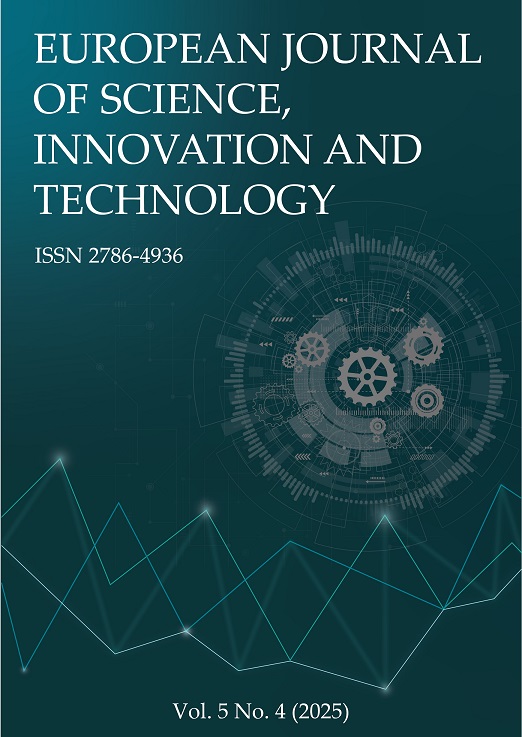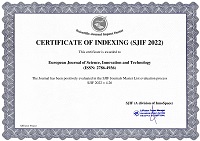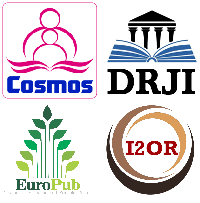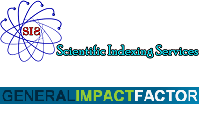Contemporary Challenges in IT: AI in Healthcare and Education
Abstract
The article examines the modern issues and possibilities of Artificial Intelligence (AI), both in healthcare and education, as two of the most pressing spheres of society that require AI implementation. As countries stay on track to achieve the United Nations Sustainable Development Goals, specifically SDG 3 (Good Health and Well-being) and SDG 4 (Quality Education), AI has become a disruptive tool that could change the way service delivery is done, how people access services, and the outcome. However, the paper stresses that AI could worsen the current inequalities unless close attention is paid to these issues through careful ethical governance, inclusive design, and investment in digital infrastructure.
AI applications in healthcare include various types of diagnostic imaging, telemedicine, clinical decision support systems, and new models of care delivered through technologies such as NLP and predictive analytics. The case studies of the U.S. and Rwanda also represent the opportunities and hazards of AI, such as diagnostic level accuracy, data fragmentation problem, algorithm bias, and minimal clinical validation.
In education, AI is used in the form of intelligent tutoring systems, adaptive assessments, and automation of administration and learning. Such efforts as adaptive learning provided by Arizona State University and the Rori AI tutor project in Ghana show opportunities related to equity and scalability. However, there is still some worry about privacy, algorithm discrimination, and ineffective teacher training.
Through a comparative analysis of the two sectors, the article provides an insightful look into their similarities, including infrastructure requirements and data bias, as well as the differences between user adoption, regulation, and risk tolerance. It proclaims cross-sectoral policy frameworks, capacity-building programs, and an ethics approach to AI design to guarantee sustainable and fair AI adoption.
References
AIPRM. (2024, July 8). 50+ AI in Healthcare Statistics 2024. Aiprm.com. https://www.aiprm.com/ai-in-healthcare-statistics/
Alkhayat, D. S., Alsubaiyi, H. N., Alharbi, Y. A., Alkahtani, L. M., Akhwan, A. M., & Alharbi, A. A. (2025). Perception and Impact of AI on Education Journey of Medical Students and Interns in Western Region, KSA: A Cross-Sectional Study. Journal of Medical Education and Curricular Development, 12. https://doi.org/10.1177/23821205251340129
Almagharbeh, W. T., Alfanash, H. A., Alnawafleh, K. A., Alasmari, A. A., Alsaraireh, F. A., Dreidi, M. M., & Nashwan, A. J. (2025). Application of artificial Intelligence in nursing practice: a qualitative study of Jordanian nurses' perspectives. BMC Nursing, 24(1). https://doi.org/10.1186/s12912-024-02658-6
Altinay, Z., Altinay, F., Sharma, R. C., Dagli, G., Shadiev, R., Yikici, B., & Altinay, M. (2024). Capacity Building for Student Teachers in Learning, Teaching Artificial Intelligence for Quality of Education. Societies, 14(8), 148. https://doi.org/10.3390/soc14080148
Aluru, K. S., & Ethan, A. (2024, January 1). Transforming Healthcare: The Role of AI in Improving Patient Outcomes. ResearchGate. https://www.researchgate.net/publication/385720661_Transforming_Healthcare_The_Role_of_AI_in_Improving_Patient_Outcomes?utm_source=
Al-Zahrani, A. M. (2024). Unveiling the Shadows: Beyond the Hype of AI in Education. Heliyon, 10(9), e30696. https://doi.org/10.1016/j.heliyon.2024.e30696
Alzghaibi, H. (2025). Nurses’ perspectives on AI-Enabled wearable health technologies: opportunities and challenges in clinical practice. BMC Nursing, 24(1). https://doi.org/10.1186/s12912-025-03343-y
AMA. (2018). HIPAA privacy rule. American Medical Association. https://www.ama-assn.org/practice-management/hipaa/hipaa-privacy-rule
Bajwa, J., Munir, U., Nori, A., & Williams, B. (2021). Artificial intelligence in healthcare: Transforming the practice of medicine. Future Healthcare Journal, 8(2), 188–194. NCBI. https://doi.org/10.7861/fhj.2021-0095
Banga, B. (2024, October 15). AI-driven telemedicine: emerging trends in 2024 - Medical Technology (Issue 79). H5mag.com. https://medical-technology.h5mag.com/medical_technology_oct24/ai-driven_telemedicine_emerging_trends_in_2024
Bekbolatova, M., Mayer, J., Ong, C. W., & Toma, M. (2024). Transformative Potential of AI in Healthcare: Definitions, Applications, and Navigating the Ethical Landscape and Public Perspectives. Healthcare, 12(2), 125–125. https://doi.org/10.3390/healthcare12020125
Bond, M., Khosravi, H., Laat, M. de, Bergdahl, N., Negrea, V., Oxley, E., Pham, P., Chong, S. W., & Siemens, G. (2024). A meta systematic review of artificial Intelligence in higher education: a call for increased ethics, collaboration, and rigour. International Journal of Educational Technology in Higher Education, 21(1). https://doi.org/10.1186/s41239-023-00436-z
CAF. (2024). Connectivity, inclusion, and digital transformation for greater progress. https://www.caf.com/media/4674393/impactocaf-connectivity-and-digital-transformation-full-report.pdf?utm_source
Cardona, M., Rodríguez, R., & Ishmael, K. (2023). Artificial Intelligence and the Future of Teaching and Learning Insights and Recommendations. Office of Educational Technology. https://www.ed.gov/sites/ed/files/documents/ai-report/ai-report.pdf
Castro, H. (2024, November 1). How AI and humans can revolutionize medicine together | Harvey Castro MD, MBA | TEDxWarrenton. YouTube; TEDx Talks. https://www.youtube.com/watch?v=SW_2NjIvuPU
Chen, P., Wu, L., & Wang, L. (2023). AI Fairness in Data Management and Analytics: A Review on Challenges, Methodologies and Applications. Applied Sciences, 13(18), 10258–10258. https://doi.org/10.3390/app131810258
Codewave. (2025, May 8). Top 10 AI Applications Across Major Industries. Codewave Insights. https://codewave.com/insights/top-ai-applications-major-industries/
Cross, J. L., Choma, M. A., & Onofrey, J. A. (2024). Bias in Medical AI: Implications for Clinical decision-making. PLOS Digital Health, 3(11), e0000651. https://doi.org/10.1371/journal.pdig.0000651
Díaz-Rodríguez, N., Del Ser, J., Coeckelbergh, M., López de Prado, M., Herrera-Viedma, E., & Herrera, F. (2023). Connecting the Dots in Trustworthy Artificial Intelligence: from AI principles, ethics, and Key Requirements to Responsible AI Systems and Regulation. Information Fusion, 99(101896), 101896. https://doi.org/10.1016/j.inffus.2023.101896
Eynon, R. (2023). Algorithmic bias and discrimination through digitalization in education: a sociotechnical view. Ora.ox; University of Oxford. https://ora.ox.ac.uk/objects/uuid:131eb97b-988b-42a0-95e9-fc60b79651aa/files/s0v838251t
Fazakarley, C.-A., Breen, M., Thompson, B., Leeson, P., & Williamson, V. (2024). Beliefs, experiences and concerns of using artificial Intelligence in healthcare: A qualitative synthesis. Digital Health, 10, 20552076241230075. https://doi.org/10.1177/20552076241230075
GCORE. (2025). Artificial Intelligence Model Life Cycle: From Creation to End-users | Gcore. Gcore.com. https://gcore.com/learning/ai-model-lifecycle
Gordon, M., Daniel, M., Aderonke Ajiboye, Hussein Uraiby, Xu, N. Y., Bartlett, R., Hanson, J., Haas, M., Spadafore, M., Ciaran Grafton-Clarke, Rayhan Yousef Gasiea, Michie, C., Corral, J., Kwan, B., Dolmans, D., & Satid Thammasitboon. (2024). A scoping review of artificial Intelligence in medical education: BEME Guide No. 84. Medical Teacher, 46(4), 1–25. https://doi.org/10.1080/0142159x.2024.2314198
Gottschalk, F., & Weise, C. (2023). Digital equity and inclusion in education: An overview of practice and policy in OECD countries OECD Education Working Paper No. 299. https://one.oecd.org/document/EDU/WKP(2023)14/en/pdf
Henkel, O., Horne-Robinson, H., Kozhakhmetova, N., & Lee, A. (2024, May 5). Effective and Scalable Math Support: Evidence on the Impact of an AI- Tutor on Math Achievement in Ghana. ArXiv.org. https://doi.org/10.48550/arXiv.2402.09809
Holmes, W., Bialik, M., & Fadel, C. (2020). Artificial Intelligence In Education Promises and Implications for Teaching and Learning. Center for Curriculum Redesign. https://curriculumredesign.org/wp-content/uploads/AIED-Book-Excerpt-CCR.pdf
Hossain, E., Rana, R., Higgins, N., Soar, J., Barua, P. D., Pisani, A. R., & Turner, K. (2023). Natural Language Processing in Electronic Health Records in relation to healthcare decision-making: A systematic review. Computers in Biology and Medicine, 155, 106649. https://doi.org/10.1016/j.compbiomed.2023.106649
Jamal Eddine, R., Gide, E., & Al-Sabbagh, A. (2025). Generative AI in higher education: A cross-sector analysis of ChatGPT’s impact on STEM, social sciences, and healthcare. STEM Education, 5(5), 757–801. https://doi.org/10.3934/steme.2025035
Javaid, M., Haleem, A., Ravi Pratap Singh, & Ahmed, M. (2024). Computer Vision to Enhance Healthcare Domain: An Overview of Features, Implementation, and Opportunities. Intelligent Pharmacy, 2(6). https://doi.org/10.1016/j.ipha.2024.05.007
Kamalov, F., Calonge, D. S., & Gurrib, I. (2023). New Era of Artificial Intelligence in Education: Towards a Sustainable Multifaceted Revolution. Sustainability, 15(16), 12451. https://doi.org/10.3390/su151612451
Khan, S. (2023, May 1). How AI Could Save (Not Destroy) Education | Sal Khan | TED. YouTube; TED. https://www.youtube.com/watch?v=hJP5GqnTrNo
Khanna, N. N., Maindarkar, M. A., Viswanathan, V., Fernandes, J. F. E., Paul, S., Bhagawati, M., Ahluwalia, P., Ruzsa, Z., Sharma, A., Kolluri, R., Singh, I. M., Laird, J. R., Fatemi, M., Alizad, A., Saba, L., Agarwal, V., Sharma, A., Teji, J. S., Al-Maini, M., & Rathore, V. (2022). Economics of Artificial Intelligence in Healthcare: Diagnosis vs. Treatment. Healthcare, 10(12), 2493. https://doi.org/10.3390/healthcare10122493
Kim, J., & Wargo, E. (2025). Empowering educational leaders for AI integration in rural STEM education: Challenges and strategies. Frontiers in Education, 10. https://doi.org/10.3389/feduc.2025.1567698
Ko, H. Y. K., Tripathi, N. K., Mozumder, C., Muengtaweepongsa, S., & Pal, I. (2023). Real-Time remote patient monitoring and alarming system for noncommunicable lifestyle diseases. International Journal of Telemedicine and Applications, 2023. https://doi.org/10.1155/2023/9965226
Marketsandmarkets. (2023). AI in Education Market Size, Share and Global Market Forecast to 2023 | MarketsandMarkets. Www.marketsandmarkets.com. https://www.marketsandmarkets.com/Market-Reports/ai-in-education-market-200371366.html
Mirea, C.-M., Bologa, R., Toma, A., Clim, A., Plăcintă, D.-D., & Bobocea, A. (2025). Transforming Learning with Generative AI: From Student Perceptions to the Design of an Educational Solution. Applied Sciences, 15(10), 5785. https://doi.org/10.3390/app15105785
Murikah, W., Nthenge, J. K., & Musyoka, F. M. (2024). Bias and Ethics of AI Systems Applied in Auditing - a Systematic Review. Scientific African, 25(e02281). https://doi.org/10.1016/j.sciaf.2024.e02281
Norori, N., Hu, Q., Aellen, F. M., Faraci, F. D., & Tzovara, A. (2021). Addressing bias in big data and AI for health care: A call for open science. Patterns, 2(10), 100347. https://doi.org/10.1016/j.patter.2021.100347
OECD. (2020). Recommendation of the Council on Artificial Intelligence. Oecd.org. https://legalinstruments.oecd.org/en/instruments/OECD-LEGAL-0449
OECD. (2023). OECD CITY NETWORK ON JOBS AND SKILLS ©OECD 2023 LEED | Good jobs, great places OECD CITY NETWORK ON JOBS AND SKILLS BRIEFING NOTE DIGITAL SKILLS AND DIGITAL INCLUSION. https://www.oecd.org/content/dam/oecd/en/about/projects/cfe/oecd-city-network-on-jobs-and-skills/Briefing-note-Digital-skills-and-digital-inclusion.pdf?utm_source
POPESCU, R.-I., Matilda SABIE, O., & TRUȘCĂ, M. (2023). The Contribution of Artificial Intelligence to Stimulating the Innovation of Educational Services and University Programs in Public Administration. Transylvanian Review of Administrative Sciences, 70 E, 85–108. https://doi.org/10.24193/tras.70e.5
Rashid, A. B., & Kausik, A. K. (2024). AI Revolutionizing Industries Worldwide: a Comprehensive Overview of Its Diverse Applications. Hybrid Advances, 7(100277), 100277–100277. https://doi.org/10.1016/j.hybadv.2024.100277
Rizinde, T., Ngaruye, I., & Cahill, N. D. (2023). Comparing Machine Learning Classifiers for Predicting Hospital Readmission of Heart Failure Patients in Rwanda. Journal of Personalized Medicine, 13(9), 1393–1393. https://doi.org/10.3390/jpm13091393
Sarker, I. H. (2021). Machine Learning: Algorithms, Real-World Applications and Research Directions. SN Computer Science, 2(3), 1–21. Springer. https://link.springer.com/article/10.1007/s42979-021-00592-x
Schiaffino, L. (2025, July 9). Improving ROI in Private Education: Is It Worth Investing in AI in 2025? Getdarwin.ai; Darwin AI. https://blog.getdarwin.ai/en/content/roi-ia-educacion?utm_source
Sharma, R. (2024, November 19). How public-private partnerships can ensure AI for good. World Economic Forum. https://www.weforum.org/stories/2024/11/public-private-partnerships-ensure-ethical-sustainable-inclusive-ai-development/
Stryker, C., & Holdsworth, J. (2024, August 11). Natural language processing. IBM. https://www.ibm.com/think/topics/natural-language-processing
Stryker, C., & Kavlakoglu, E. (2024, August 9). What is artificial Intelligence (AI)? IBM. https://www.ibm.com/think/topics/artificial-intelligence
Stuti Dhruv. (2025, June 23). The Cost of Implementing AI in Healthcare. Aalpha; Aalpha Information Systems India PVT LTD. https://www.aalpha.net/blog/cost-of-implementing-ai-in-healthcare/?utm_source
Sweeney, E. (2025, July 23). Cedars-Sinai’s AI tool delivered 24/7 care to 42,000 patients. Now, doctors can focus more on treatment, less on paperwork. Business Insider Africa. https://africa.businessinsider.com/news/cedars-sinais-ai-tool-delivered-247-care-to-42000-patients-now-doctors-can-focus-more/qc5bxb2
Talbert, R. (2025, January 13). How AI is changing my grading approach -- for now. Gradingforgrowth.com; Grading for Growth. https://gradingforgrowth.com/p/how-ai-is-changing-my-grading-approach
Tesene, M., Vignare, K., & Lorenzo, G. (2022, May 26). Case Study: Arizona State University – Every Learner Everywhere. Every Learner Everywhere. http://www.everylearnereverywhere.org/resources/case-study-arizona-state-university-asu/
Tippetts, M. M., Davis, B., Nalbone, S., & Zick, C. D. (2022). Thx 4 the msg: Assessing the Impact of Texting on Student Engagement and Persistence. Research in Higher Education, 63(6), 1073–1093. https://doi.org/10.1007/s11162-022-09678-8
Transform Health. (2022). CLOSING THE DIGITAL DIVIDE: MORE AND BETTER FUNDING FOR THE DIGITAL TRANSFORMATION OF HEALTH A Conceptual Framework to guide investments and action towards health for all in the digital age. https://transformhealthcoalition.org/wp-content/uploads/2022/10/Closing-the-digital-divide-mainReport.pdf
UNDP. (2025). Sustainable Development Goals. United Nations Development Programme; United Nations. https://www.undp.org/sustainable-development-goals
UNESCO. (2023). Artificial intelligence and the Futures of Learning | UNESCO. Www.unesco.org. https://www.unesco.org/en/digital-education/ai-future-learning
UNESCO. (2025). Artificial Intelligence and education: Protecting human agency in a world of automation. Eastern Africa celebrates the International Day of Education. Unesco.org. https://www.unesco.org/en/articles/artificial-intelligence-and-education-protecting-human-agency-world-automation-eastern-africa
UNESCO. (2025). UIS Data Browser. Unesco.org. https://databrowser.uis.unesco.org/resources/glossary/3145?utm_source
United Nations. (2025). The 17 sustainable development goals. United Nations. https://sdgs.un.org/goals
Vargas-Santiago, M., León-Velasco, D. A., Maldonado-Sifuentes, C. E., & Chanona-Hernandez, L. (2025). A State-of-the-Art Review of Artificial Intelligence (AI) Applications in Healthcare: Advances in Diabetes, Cancer, Epidemiology, and Mortality Prediction. Computers, 14(4), 143–143. https://doi.org/10.3390/computers14040143
Varnosfaderani, S. M., & Forouzanfar, M. (2024). The Role of AI in Hospitals and Clinics: Transforming Healthcare in the 21st Century. Bioengineering, 11(4), 1–38. https://www.mdpi.com/2306-5354/11/4/337
Vieriu, A. M., & Petrea, G. (2025). The Impact of Artificial Intelligence (AI) on Students’ Academic Development. Education Sciences, 15(3), 343. https://doi.org/10.3390/educsci15030343
Wang, Q., Ning, Z., & Tan, M. (2025). A study on the impact of digital infrastructure development on the health of low-income rural residents: based on panel data from 2010 to 2022. Frontiers in Public Health, 13. https://doi.org/10.3389/fpubh.2025.1503522
Williams, K., Axelsen, M., & Brea, E. (2024). Navigating data governance challenges in healthcare. Journal of Information Technology Teaching Cases. https://doi.org/10.1177/20438869241240493
Williamson, B., & Eynon, R. (2020). Historical threads, missing links, and future directions in AI in education. Learning, Media and Technology, 45(3), 1–13. https://doi.org/10.1080/17439884.2020.1798995
Williamson, S. M., & Prybutok, V. (2024). Balancing Privacy and Progress: A Review of Privacy Challenges, Systemic Oversight, and Patient Perceptions in AI-Driven Healthcare. Applied Sciences, 14(2), 675. https://doi.org/10.3390/app14020675
Wilson, L., Smith, J., Wood, H., & James, A. (2024, October 1). Evaluating the Impact of AI Teaching Assistants on Student Learning Outcomes in Digital Classrooms. https://www.researchgate.net/publication/393472336_Evaluating_the_Impact_of_AI_Teaching_Assistants_on_Student_Learning_Outcomes_in_Digital_Classrooms
World Economic Forum. (2025, March 7). How Rwanda is using AI to transform healthcare. World Economic Forum. https://www.weforum.org/videos/c4ir-rwanda/?utm_source=chatgpt.com
Xue, Y., Chinapah, V., & Zhu, C. (2025). A Comparative Analysis of AI Privacy Concerns in Higher Education: News Coverage in China and Western Countries. Education Sciences, 15(6), 650–650. https://doi.org/10.3390/educsci15060650
Yaseen, H., Mohammad, A. S., Ashal, N., Abusaimeh, H., Ali, A., & Ahmad Sharabati, A.-A. (2025). The Impact of Adaptive Learning Technologies, Personalized Feedback, and Interactive AI Tools on Student Engagement: The Moderating Role of Digital Literacy. Sustainability, 17(3), 1133–1133. https://doi.org/10.3390/su17031133
Younis, H. A., Eisa, T. A. E., Nasser, M., Sahib, T. M., Noor, A. A., Alyasiri, O. M., Salisu, S., Hayder, I. M., & Younis, H. A. (2024). A Systematic Review and Meta-Analysis of Artificial Intelligence Tools in Medicine and Healthcare: Applications, Considerations, Limitations, Motivation and Challenges. Diagnostics, 14(1), 109. https://doi.org/10.3390/diagnostics14010109
Zamiri, M., & Esmaeili, A. (2024). Methods and technologies for supporting knowledge sharing within learning communities: A systematic literature review. Administrative Sciences, 14(1), 1–34. https://doi.org/10.3390/admsci14010017
Zeltzer, D., Kugler, Z., Hayat, L., Brufman, T., Ilan Ber, R., Leibovich, K., Beer, T., Frank, I., Shaul, R., Goldzweig, C., & Pevnick, J. (2025). Comparison of Initial Artificial Intelligence (AI) and Final Physician Recommendations in AI-Assisted Virtual Urgent Care Visits. Annals of Internal Medicine. https://doi.org/10.7326/annals-24-03283
Zhang, X., & Saltman, R. (2021). Impact of electronic health records interoperability on telehealth service outcomes. JMIR Medical Informatics, 10(1). https://doi.org/10.2196/31837
Zuhair, V., Babar, A., Ali, R., Olatunde Oduoye, M., Noor, Z., Chris, K., Okon, I., & Ur Rehman, L. (2024). Exploring the Impact of Artificial Intelligence on Global Health and Enhancing Healthcare in Developing Nations. Journal of Primary Care & Community Health, 15(1). https://doi.org/10.1177/21501319241245847
Copyright (c) 2025 Bongs Lainjo

This work is licensed under a Creative Commons Attribution 4.0 International License.


 ISSN
ISSN 











